Dynamic window materials
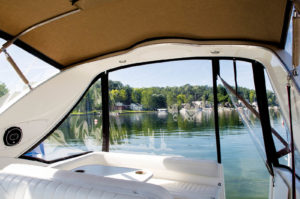
Flexible clear vinyl, shown here, is just one option for boat windows. Polycarbonate and acrylic are the other main choices. Each have their advantages in specific applications. Photo: Sailrite.
Fabricators and boat owners have a world of choices in windows.
When it comes to choosing their windows, most boat owners don’t want to make it too complicated—they want a quality product that will last at a reasonable price.
As fabricators know, however, it’s not quite that simple.
In fact, according to Zach Grant, marketing manager at Sailrite®, a distributor of marine fabrics and supplies for do-it-yourselfers in Columbia City, Ind., boat owners really need to consider at least six different things when looking for windows: clarity, scratch resistance, UV resistance, stain/chemical resistance, flexibility and cost.
“Actually, though,” Grant says, “longevity is what most boat owners are concerned with. But those six factors are what will contribute to how long windows will last.”
“The typical boat owner is concerned with enclosure functionality and durability,” adds Craig Zola, vice president of marketing and distribution for Herculite® Products Inc., a manufacturer of marine fabrics and materials, including Strataglass, located in Fort Lauderdale, Fla. “Windows are expensive and boat owners want clear products that last.”
With all the considerations that go into purchasing windows, boat owners face a myriad of choices. They rely on fabricators to not only sell and install their windows, but to help them wade through the many options and make recommendations based on their individual needs and wants.
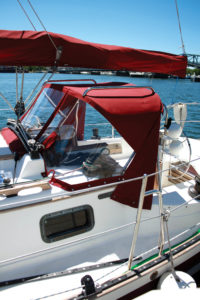
This dodger, the work of Dorsal LLC, a canvas shop in Sturgeon Bay, Wis., has an enclosure made of 40 gauge Strataglass, from Herculite Products Inc.
Three main categories
First, there are three main window types: flexible clear vinyl, polycarbonate sheets and acrylic sheets.
Here are the qualities of each, as described by Zola:
Flexible clear vinyl: “This is a great choice for many boat owners because of its breathability, suppleness and recent advances in technology like Strataglass’s scratch-resistant and UV-resistant coatings. This material is clear plastic and is soft and flexible, so it can be rolled up when not in use. It also has excellent stability and durability, and is inherently fire-retardant, waterproof and mildew resistant.”
Polycarbonate: “This is also a super-clear plastic, but it’s semirigid, making it hard and nearly unbreakable. The material can also be coated with UV-resistant technology and is also waterproof. However, it can’t be rolled up like vinyl and it can cost more to replace when damaged.”
Acrylic: “This is another semirigid option that is inherently UV resistant. It’s clear and strong. It’s not as scratch resistant, but scratches are usually repairable. It’s also not flexible enough to be rolled up.”
Given the clear difference in attributes among the categories, the type of vessel a boat owner has (along with personal preferences) may make it somewhat obvious which window type is appropriate. But within the categories, there are important distinctions that may not seem so apparent at first glance.
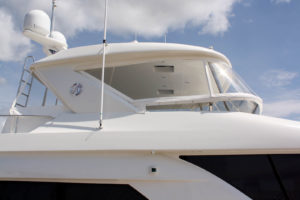
This Ocean Alexander was done by Dorsal LLC with Clear2sea UV, an acrylic enclosure. Photos: Dorsal LLC.
For example, many leading manufacturers of flexible clear vinyl, such as Strataglass, O’Sea®, Regalite® and CrystalClear, are made using the “press-polish” method.
“Pressed-polished window products are made by taking two layers of clear vinyl, which are heated until on the verge of melting and then pressed together between highly polished chrome plates to ensure a consistent thickness which is smooth and free of flaws,” Grant explains. “That creates one thicker, polished sheet with excellent optical clarity.”
Pressed-polished sheets offer the best tint consistency, clarity and dimensional stability, he says.
Saving with extruded
A less expensive option for flexible windows is extruded clear vinyl. “The raw material is heated and extruded through a series of roller presses to the desired thickness,” Grant notes. “That allows it to be produced quickly at a low cost.”
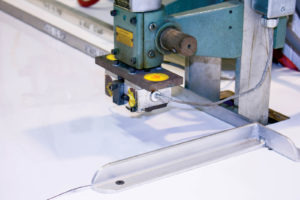
Boat windows at O’Sullivan Films Inc., Winchester, Va., are produced under
the O’Sea® and Regalite® brands.
O’Sea is the company’s coated line.
Photo: O’Sullivan Films Inc.
The softness and flexibility of extruded vinyl means the surface may be more prone to scratching, he says, but for a boat owner looking at price, it can be an appropriate choice for applications that don’t see prolonged exposure to the environment.
Extruded vinyl has excellent clarity with negligible defects and is a cost-effective alternative for most users, according to Linda Pieta, sales coordinator at Robeco Inc., a Garden City, N.Y., supplier of plastic films and sheeting, including extruded vinyl that is available plain or with a scratch-resistant coating.
There are additional options for the budget-minded, but they come with trade-offs, Pieta says. “When price is a consideration, the least expensive vinyls are calendered and laminated, but they can have imperfections such as gels and flow lines,” she says. “If the customer doesn’t worry about the window being perfect, then they can use those products.”
Coated or uncoated?
As Zola noted, advances in technology have increased the quality and popularity of coated boat windows, but many manufacturers continue to make both coated and uncoated products available, and not just because of price concerns. For example, O’Sullivan Films Inc., Winchester, Va., makes coated products under the O’Sea brand and uncoated products under the Regalite banner, according to Julie Tinsman, the company’s senior sales manager.
“There are people who want only a coated product, but also those who want only uncoated, thinking they might corrode or for some other reason,” Tinsman says. “People have different theories, but it often just comes down to past experience or personal preferences.”
Manufacturers and fabricators both point out that coated window materials help prevent or minimize a number of problems, including scratching. But exposure to the sun may be the most important consideration. “Exposure to UV is the leading cause of clear vinyl failure,” according to Grant. “UV exposure leads to the evaporation of plasticizers, which keeps the vinyl flexible. This leads to the vinyl becoming brittle, cloudy and eventually cracking. Coatings lock in the plasticizers, allowing them to stand up better.”
Tinsman also says that anyone who boats in an “environmentally tough area” should consider coated products. “A plane, for example, can spew fuel that can damage the vinyl on boats,” so if you boat near an airport, coated products can protect against that.
In addition, she says, the O’Sea coated product also makes is easier for wiping off suntan lotion, bug spray or other chemicals that might be used around boats.
There are, however, reasons besides price not to choose coated windows. “Strataglass and O’Sea coated vinyl products will not work with HH-66 (vinyl cement),” Grant says, “which makes it impossible to glue the new vinyl to an old vinyl border. So you can only use it if you are going to sew the material.”
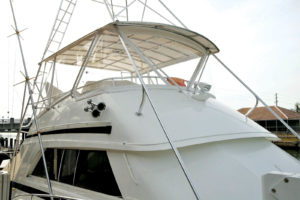
Recent advances in UV- and scratch-resistance are selling points for Strataglass, used on the boat shown here. Fabricated by Marco Canvas & Upholstery LLC, Marco Island, Fla., it features an exclusive See2Sea™ bonded acrylic enclosure with large pin-up front V panel, heat molded corners and Herculite® Riviera Marine Fabric®. Photo: Marco Canvas & Upholstery LLC.
Gauge is a consideration
Thickness is another consideration when choosing windows. “Determining the best gauge is where the fabricator needs to work very closely with the boat owner,” Tinsman says.
Charles Klein, founder and owner of Dorsal LLC, a canvas shop in Sturgeon Bay, Wis., says he generally recommends 40 gauge for forward windows and 30 gauge for side and aft windows. “Side and aft windows are more likely to get rolled up, and 30 gauge is a little more malleable,” he says.
Klein favors acrylic windows for his customers. “It is naturally scratch and UV resistant, without requiring coatings, so if it is scratched, it can be buffed out. Also, the clarity is stunning—clearer than glass.”
Greg Keeler, owner of Oyster Creek Canvas Co. in Bellingham, Wash., uses a polycarbonate, Tuffak® AR (formerly Makrolon® AR), for many of his projects where the windows are not going to be removed. Keeler favors 60 gauge in that application, but will drop down to 40 gauge in some instances. “If somebody wants to replace a window and they want to just get a few more years out of their canvas, 40 gauge is good because it’s easier to work with,” he says.
Longevity is critical
Thicker gauge materials often improve a window’s life span, and that’s often the most critical part of the equation, Klein says.
“Is it worth paying the extra money for a better product?” Klein asks. “Labor can cost significantly more than the cost of materials,” he says. “Some products will last 10 years or more, but others—like extruded vinyl without any UV or scratch-resistant coatings—might give you only three or four seasons. It’s kind of foolish to spend money to come back in three or four years and pay for labor again.”
Fabricators aren’t usually interested in doing projects with inferior materials anyway, Keeler says, and it’s not necessarily because of the money.
“When I build something, it doesn’t have to be top of the line,” Keeler explains. “But when I put the effort in, I want it to be nice and I want it to look good.”
Jeff Moravec is a freelance writer from Minneapolis, Minn.
 TEXTILES.ORG
TEXTILES.ORG 






